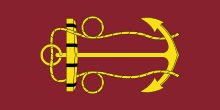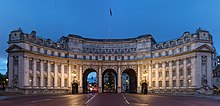Admiralty (United Kingdom)
 |
| His Majesty's Naval Service of the British Armed Forces |
|---|
| Components |
|
| History and future |
| Ships |
| Personnel |
| Auxiliary services |
The Admiralty was the organisation responsible for the command of the Royal Navy in the Kingdom of England, and later in Great Britain, and until 1964 in the United Kingdom. Originally exercised by a single person, the Lord High Admiral, the Admiralty was, from the early 18th century onwards, almost invariably put "in commission" and exercised by the Lords Commissioners of the Admiralty, who sat on the Board of Admiralty.
In 1964, the functions of the Admiralty were transferred to a new Admiralty Board, which is a committee of the tri-service Defence Council of the United Kingdom and part of the Ministry of Defence. The new Admiralty Board meets only twice a year, and the day-to-day running of the Royal Navy is controlled by a Navy Board (not to be confused with the historic Navy Board described later in this article). It is common for the various authorities now in charge of the Royal Navy to be referred to as simply The Admiralty.
The title of Lord High Admiral of the United Kingdom was vested in the monarch from 1964 to 2011. The title was awarded to Philip, Duke of Edinburgh by Queen Elizabeth II on his 90th birthday.[1] There also continues to be a Vice-Admiral of the United Kingdom and a Rear-Admiral of the United Kingdom, both of which are honorary offices.
Function and organisation
History

The office of Admiral of England (or Lord Admiral and later Lord High Admiral) was created around 1400 although there had already been Admirals of the Northern and Western Seas. In 1546, King Henry VIII established the Council of the Marine, later to become the Navy Board, to oversee administrative affairs of the naval service. Operational control of the Royal Navy remained the responsibility of the Lord High Admiral, who was one of the nine Great Officers of State.
In 1628, Charles I put the office of Lord High Admiral into commission and control of the Royal Navy passed to a committee in the form of the Board of Admiralty. The office of Lord High Admiral passed a number of times in and out of commission until 1709 after which the office was almost permanently in commission (the last Lord High Admiral being the future King William IV in the early 19th century).
In 1831, the Navy Board was abolished as a separate entity, and its duties and responsibilities were given over to the Admiralty.
In 1964, the Admiralty was subsumed into the Ministry of Defence along with the War Office and the Air Ministry. Within the expanded Ministry of Defence are the new Admiralty Board, Army Board and Air Force Board, each headed by the Secretary of State for Defence. As mentioned above, there is also a new Navy Board in charge of the day-to-day running of the Royal Navy.
Board of Admiralty

When the office of Lord High Admiral was in commission, as it was for most of the 18th, 19th and 20th centuries, until it reverted to the Crown, it was exercised by a Board of Admiralty, officially known as the Commissioners for Exercising the Office of Lord High Admiral of the United Kingdom of Great Britain and Northern Ireland, &c. (alternatively of England, Great Britain or the United Kingdom of Great Britain and Ireland depending on the period).
The Board of Admiralty consisted of a number of Lords Commissioners of the Admiralty. The Lords Commissioners were always a mixture of admirals, known as Naval Lords or Sea Lords and Civil Lords, normally politicians. The quorum of the Board was two commissioners and a secretary.
The president of the Board was known as the First Lord of the Admiralty, who was a member of the Cabinet. After 1806, the First Lord of the Admiralty was always a civilian while the professional head of the navy came to be (and is still today) known as the First Sea Lord.
Admiralty buildings

The Admiralty complex lies between Whitehall, Horse Guards Parade and The Mall and includes five inter-connected buildings. Since the Admiralty no longer exists as a department, these buildings are now used by separate government departments:
The Admiralty
The oldest building was long known simply as The Admiralty; it is now known officially as the Ripley Building, a three storey U-shaped brick building designed by Thomas Ripley and completed in 1726. Alexander Pope implied the architecture is rather dull, lacking either the vigour of the baroque style, fading from fashion at the time, or the austere grandeur of the Palladian style just coming into vogue. It is mainly notable for being perhaps the first purpose-built office building in Great Britain. It contained the Admiralty board room, which is still used by the Admiralty, other state rooms, offices and apartments for the Lords of the Admiralty. Robert Adam designed the screen, which was added to the entrance front in 1788. The Ripley Building is currently occupied by the Department for International Development.
-
Old Admiralty (Ripley Building) in 1760 before addition of the Adam screen
-
Old Admiralty (Ripley Building) c. 1790 after addition of the Adam screen
-
Old Admiralty (Ripley Building) c. 1830
Admiralty House
Admiralty House is a moderately proportioned mansion to the south of the Ripley Building, built in the late 18th century as the residence of the First Lord of the Admiralty. It served that purpose until 1964. Winston Churchill was one of its occupants. It lacks its own entrance from Whitehall and is entered through the Ripley Building. It is a three-storey building in yellow brick with neoclassical interiors. Its rear facade faces directly onto Horse Guards Parade. The architect was Samuel Pepys Cockerell. There are now three ministerial flats in the building, which were unoccupied in 2012.[2]
Admiralty Extension

This is the largest of the Admiralty Buildings. It was begun in the late 19th century and redesigned while the construction was in progress to accommodate the extra offices needed by the naval arms race with the German Empire. It is a red brick building with white stone, detailing in the Queen Anne style with French influences. It has been used by the Foreign and Commonwealth Office since the 1960s. The Department for Education will move into the building in September 2017 following the Foreign and Commonwealth Office's decision to leave the building and consolidate its London staff into one building on King Charles Street.
Admiralty Arch

Admiralty Arch is linked to the Old Admiralty Building by a bridge and is part of the ceremonial route from Trafalgar Square to Buckingham Palace.
The Admiralty Citadel
This is a squat, windowless World War II fortress north west of Horse Guards Parade, now covered in ivy. See Military citadels under London for further details.
"Admiralty" as a metonym for "sea power"

In some cases, the term admiralty is used in a wider sense, as meaning sea power or rule over the seas, rather than in strict reference to the institution exercising such power. For example, the well-known lines from Kipling's Song of the Dead:
If blood be the price of admiralty, Lord God, we ha' paid in full!
See also
- Admiralty administration
- List of Lords High Admiral
- List of the First Lords of the Admiralty
- List of Lords Commissioners of the Admiralty
- Lord High Admiral of Scotland
- St Boniface's Catholic College
- Admiralty chart
References
- ^ "New title for Duke of Edinburgh as he turns 90, who remains the incumbent". BBC news. BBC. 10 June 2011. Retrieved 10 June 2011.
- ^ Ministerial Residences
Further reading
The Building
- Bradley, Simon, and Nikolaus Pevsner. London 6: Westminster (from the Buildings of England series). New Haven, Connecticut: Yale University Press, 2003. ISBN 0-300-09595-3.
- C. Hussey, "Admiralty Building, Whitehall", Country Life, 17 and 24 November 1923, pp. 684–692, 718–726.
The Office
- Daniel A. Baugh, Naval Administration in the Age of Walpole (Princeton, 1965).
- Sir John Barrow, An Autobiographical Memoir of Sir John Barrow, Bart., Late of the Admiralty (London, 1847).
- John Ehrman, The Navy in the War of William III: Its State and Direction (Cambridge, 1953).
- C. I. Hamilton, The Making of the Modern Admiralty: British Naval Policy-Making 1805–1927 (Cambridge: Cambridge University Press, 2011).
- C. I. Hamilton, "Selections from the Phinn Committee of Inquiry of October–November 1853 into the State of the Office of Secretary to the Admiralty, in The Naval Miscellany, volume V, edited by N. A. M. Rodger, (London: Navy Records Society, London, 1984).
- C. S. Knighton, Pepys and the Navy (Stroud: Sutton Publishing, 2003).
- Christopher Lloyd, Mr Barrow of the Admiralty (London, 1970).
- Malcolm H. Murfett, The First Sea Lords: From Fisher to Mountbatten (Westport: Praeger, 1995).
- Lady Murray, The Making of a Civil Servant: Sir Oswyn Murray, Secretary of the Admiralty 1917–1936 (London, 1940).
- N.A.M. Rodger, The Admiralty (Lavenham, 1979)
- J.C. Sainty, Admiralty Officials, 1660–1870 (London, 1975)
- Sir Charles Walker, Thirty-Six Years at the Admiralty (London, 1933)
External links
- The Admiralty at the Survey of London online





